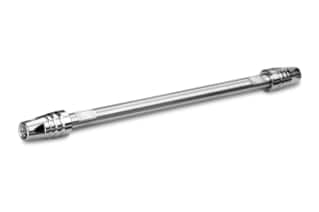
|
Chemistry |
C18 |
|
Separation Mode |
Reversed Phase |
|
Particle Substrate |
Silica |
|
pH Range Min |
2 pH |
|
pH Range Max |
8 pH |
|
Temperature Limits |
45 C |
|
Maximum Pressure |
18000 psi (1240 Bar) |
|
Endcapped |
Yes |
|
Bonding Technology |
C18+ |
|
Silanol Activity |
Low |
|
Particle Shape |
Spherical |
|
Particle Size |
2.7 µm |
|
Endfitting Type |
Parker-style |
|
Pore Size |
90 Å |
|
Format |
Method Validation Kit |
|
Surface Area |
100 |
|
System |
HPLC |
|
Particle Technology |
Solid Core |
|
USP Classification |
L1 |
|
Inner Diameter |
3 mm |
|
Length |
150 mm |
|
Carbon Load |
5.7 % |
|
eCord |
Yes |
|
UNSPSC |
41115709 |
|
Brand |
CORTECS |
|
Product Type |
Column Kits |
|
Units per Package |
3 pk |

CORTECS C18+ Method Validation Kit, 90Å, 2.7 µm, 3 mm X 150 mm, 3/pk
CORTECS C18+ columns are high-efficiency C18 columns with a charged surface that are designed to give excellent peak shape for basic analytes at low pH. To obtain faster separations and higher throughput, use the CORTECS C18+ Column. The laboratory apparatus is a high-efficiency reversed-phase column with a positively charged surface that produces an excellent peak shape for basic chemicals at low pH. Scientists like the C18 ligand in the CORTECS C18+ Column because of its outstanding retention and stability. The column is an important piece of scientific equipment because it allows you to resolve difficult mixes or retain resolution while improving throughput.
The CORTECS Solid Core C18+ Column is made up of solid-core particles that improve performance by decreasing each of the van Deemter equation's three terms. As the solid core particles pack more uniformly, the A term decreases. Because the solid core particles have lower particle porosity, axial diffusion is reduced, and the B term is reduced. Their solid core enhances heat transport and reduces radial temperature gradients, lowering the C term.
When compared to the original separation, the CORTECS C18+ Column allows for a shorter column length while keeping identical peak capacities and delivering faster re-equilibration durations. This advantage of fast analysis without sacrificing separation performance allows you to run more samples in parallel, lowering your lab operation costs. Furthermore, by simply increasing the flow rate of the technique, you can increase sample throughput with equivalent or even superior peak capacities.
The CORTECS C18+ Column has excellent resolution selectivity. You can create methods faster thanks to its revolutionary particle-surface changes and unique substrate features. Check out our website to learn more about the chemistry of the CORTECS C18+ Column and its various versions. It also allows you to shop for lab equipment and contains our whole product line to fulfill your analytical needs.
You may also benefit from reviewing CORTECS C18+ VanGuard Cartridge, 90Å, 2.7 µm, 2.1 mm X 5 mm, 3/pk; CORTECS C18+ VanGuard Cartridges are used to extend analytical column lifetime and performance by removing particulate contamination from the mobile phase stream. This cartridge is optimized to protect all 2.1 mm and 3.0 mm I.D. CORTECS C18+ analytical columns containing 2.7 µm sorbent particles.
What Is Elution And How Does It Work?
The chromatographic process of extracting an adsorbed substance from a solid adsorbing media with a solvent, or the removal of an antibody from the antigen to which it is attached, is known as elution. The eluent or eluant is the "carrier" element of the mobile phase that transports the analytes through the chromatograph during the process.